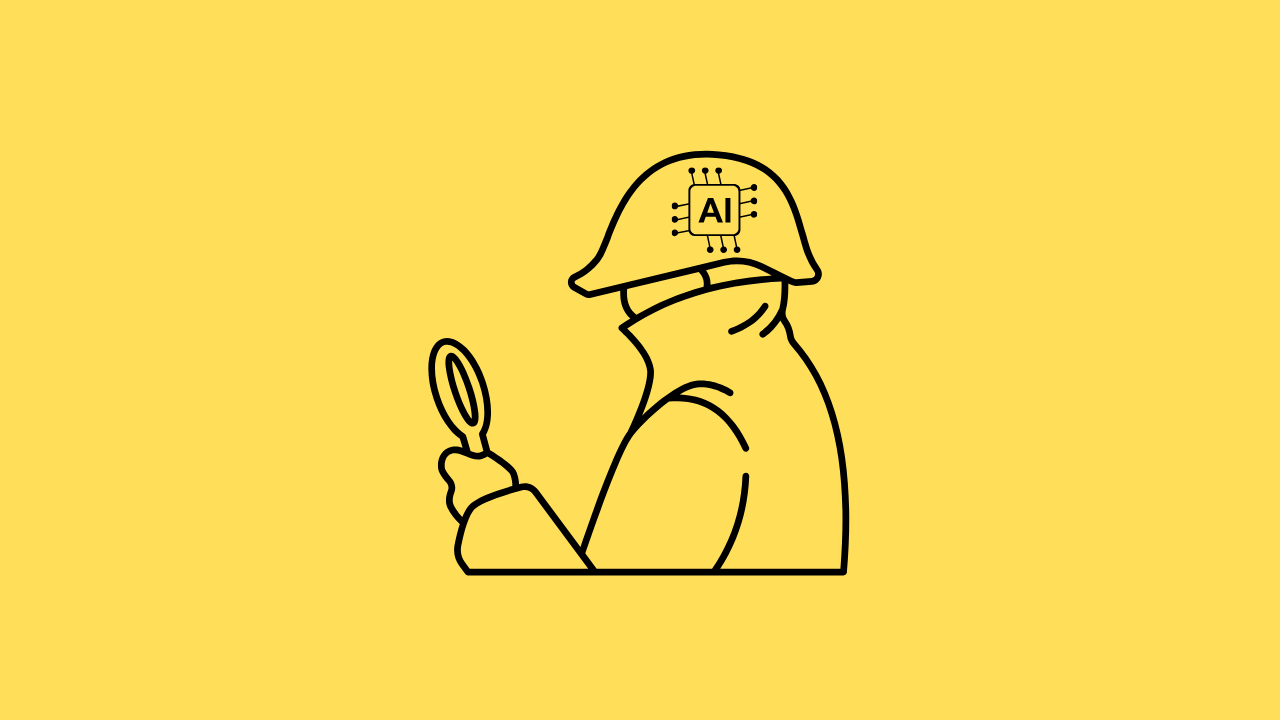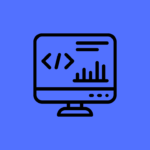Introduction
In an era where digital content proliferates at an unprecedented rate, the need for effective AI content detection tools has never been greater. These tools help ensure that the content we consume and create is authentic, original, and free from plagiarism or unauthorized AI generation. In this comprehensive guide, we will delve into the top 10 AI tools for AI content detection, exploring their features, benefits, and how they can safeguard your content integrity.
What is AI Content Detection?
AI content detection refers to the use of artificial intelligence to identify and analyze text or multimedia content. This technology helps detect plagiarism, AI-generated content, and other forms of content manipulation. By leveraging advanced algorithms, these tools can provide a detailed analysis of content authenticity, ensuring it meets the desired standards of originality and credibility.
Top 10 AI Tools for AI Content Detection
1. GPTZero
GPTZero is one of the earliest and most popular AI detection tools, built specifically to identify ChatGPT and other AI-written content. It analyzes perplexity (text predictability) and burstiness (variation in sentence structure) to determine whether text is machine-generated. The platform provides a detailed report highlighting suspicious sections and is widely used by schools, universities, and journalists for authenticity checks.
Best for:
Educators and content reviewers who need fast, reliable AI writing detection for academic or editorial content.
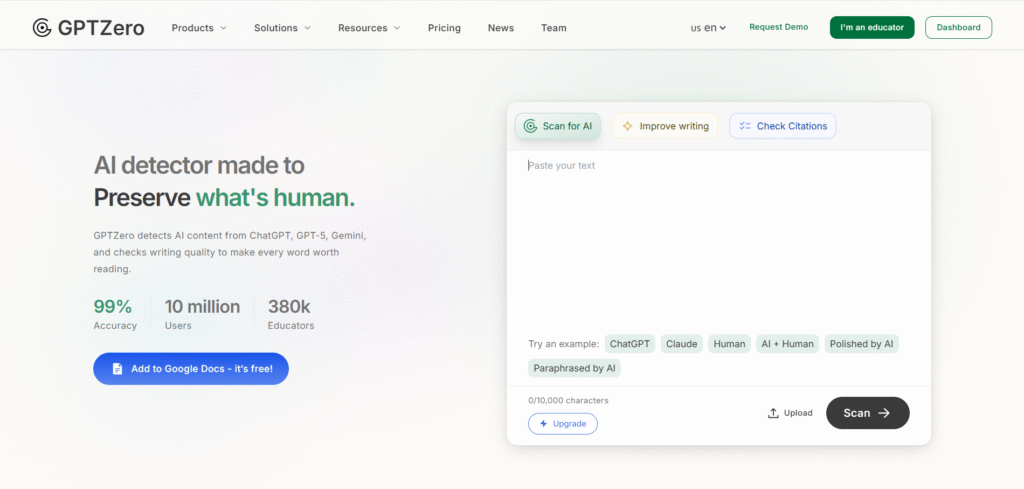
2. Copyleaks AI Content Detecto
Copyleaks uses advanced neural network analysis and NLP models to detect AI-generated text across over 30 languages. It can identify content from models like GPT-3, GPT-4, Bard, and Claude, while maintaining over 99% claimed accuracy. The tool integrates with LMS systems, CMS platforms, and enterprise workflows, making it ideal for large organizations ensuring content integrity.
Best for:
Enterprises, publishers, and educators seeking multilingual AI detection with high accuracy and API integration.
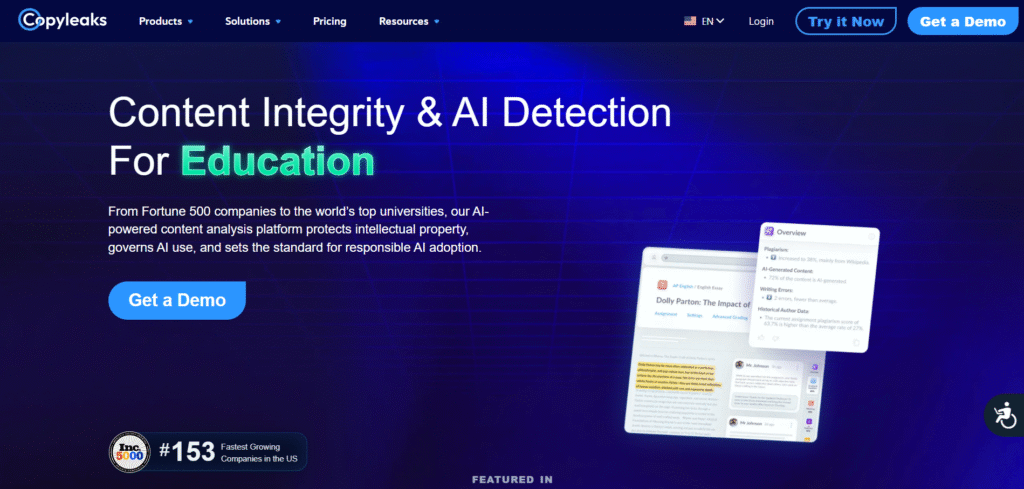
3. QuillBot AI Detector
Known for its paraphrasing tool, QuillBot also offers an integrated AI Content Detector that scans text for AI-writing patterns. It analyzes tone, consistency, and probability metrics to flag AI-generated portions. QuillBot’s intuitive interface makes it ideal for writers who want to self-check their work for authenticity before submission or publication.
Best for:
Writers, students, and editors who want a built-in AI detection check within their writing toolkit.
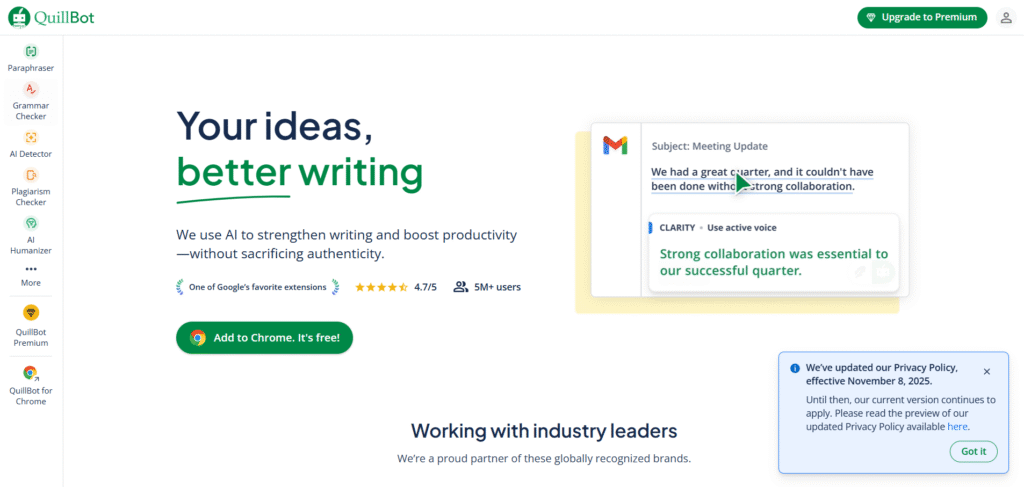
4. Writer AI Content Detector
Writer’s AI Detector helps users verify whether content was produced by AI tools such as ChatGPT or Jasper. It provides a percentage-based detection score and highlights sections that seem algorithmically written. Since it’s part of the broader Writer.com ecosystem, it also offers plagiarism checks and tone guidance — making it useful for editorial teams.
Best for:
Marketing and editorial teams looking for combined AI detection and writing quality assurance.
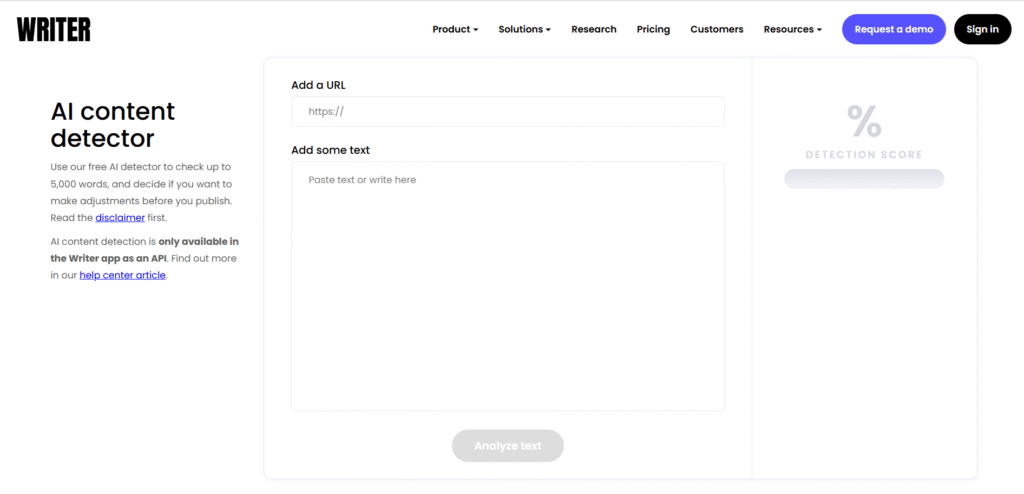
5. Scribbr AI Detector
Scribbr, trusted by academic institutions, offers a precise AI text detector that checks essays, theses, and research papers for signs of AI involvement. It detects full or partial AI authorship and offers paragraph-level analysis for detailed feedback. Combined with plagiarism detection, it’s particularly popular in universities and research environments.
Best for:
Students, professors, and researchers needing academic-grade AI detection.
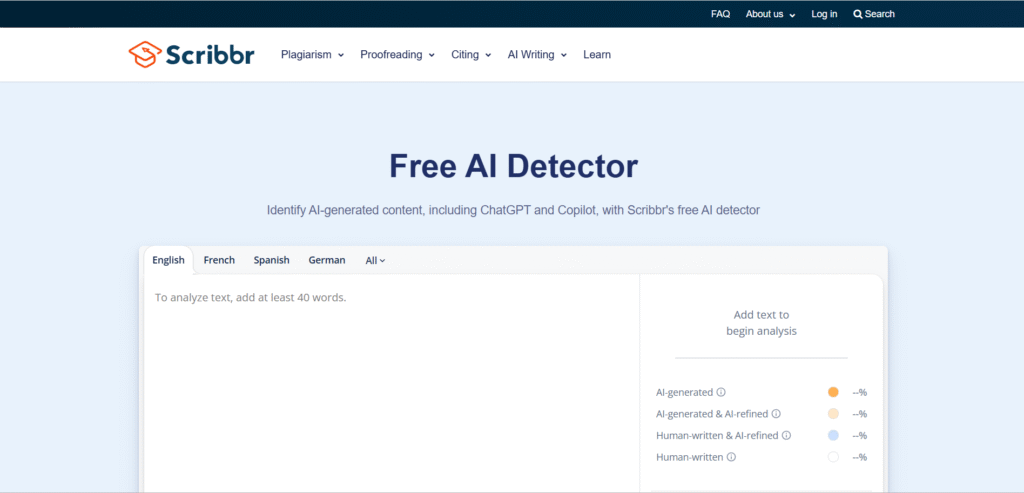
6. Grammarly AI Detector
Grammarly, already a leader in writing assistance, has added an AI Content Detector to its platform. It estimates how much of a document appears AI-generated, offering a “likely human-written” or “AI-influenced” confidence score. This feature works alongside Grammarly’s grammar, tone, and plagiarism tools — creating an all-in-one content integrity suite.
Best for:
Professionals and content creators who need AI detection within a full writing support ecosystem.
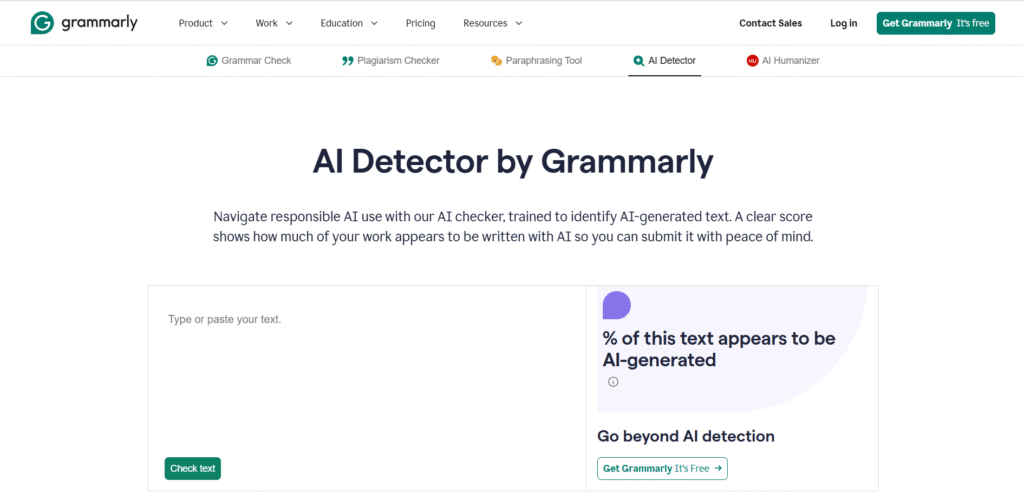
7. ZeroGPT
ZeroGPT uses a multi-layered analysis model to detect AI text patterns from GPT-2 through GPT-4. It evaluates semantic structure, token distribution, and entropy to calculate an “AI Probability Score.” ZeroGPT also offers a batch text analysis feature and Chrome extension, making it a favorite among educators and SEO professionals monitoring content authenticity.
Best for:
Educators, SEO experts, and content auditors who want quick detection with AI probability scores.
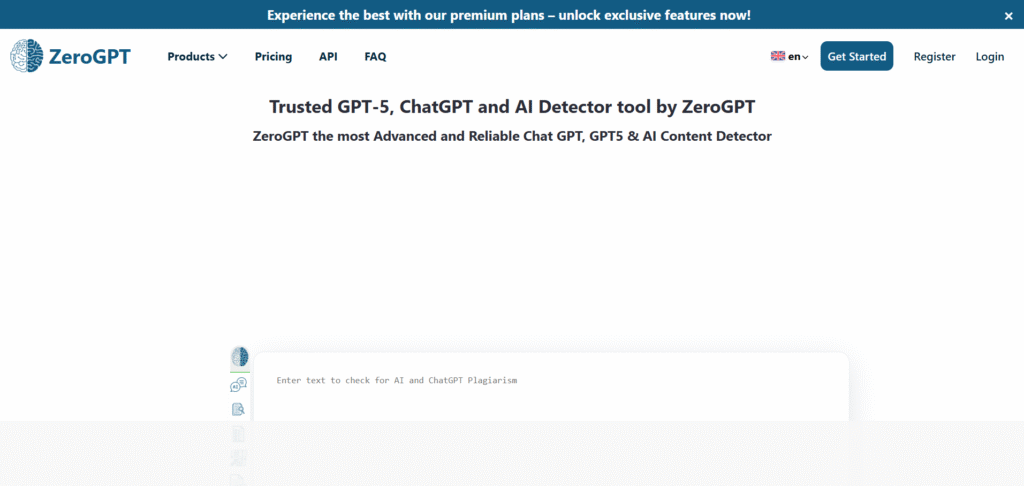
8. Originality.AI
Originality.AI is a professional-grade AI and plagiarism detection platform used by publishers, bloggers, and SEO agencies. It scans for both AI-generated and copied content simultaneously. Its detailed reports show content origin, sentence-level flags, and detection confidence scores. The platform also provides team collaboration features, making it ideal for editorial workflows.
Best for:
Publishers and agencies needing AI + plagiarism detection for large-scale content operations.
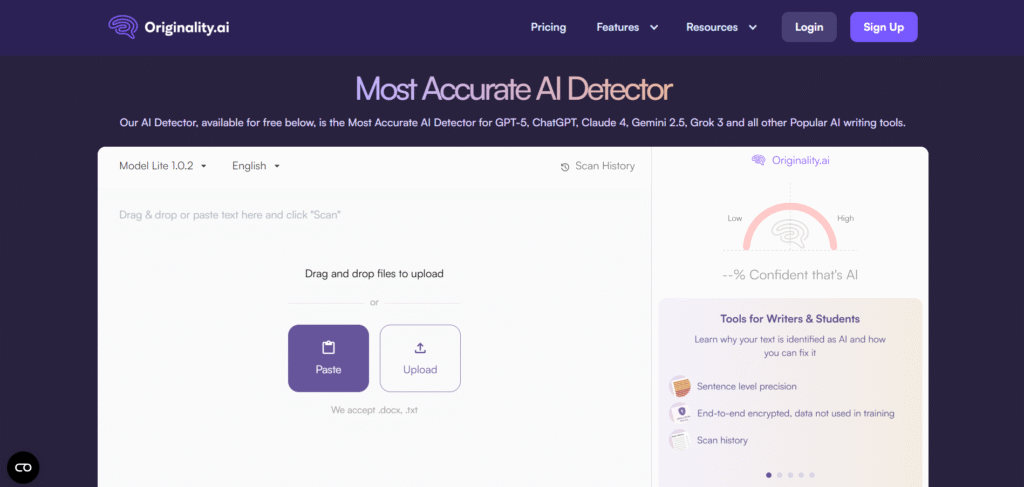
9. Pangram Labs AI Detector
Pangram Labs offers an AI content detection system capable of identifying which large language model (e.g., GPT, Claude, Gemini) likely generated a given text. It’s designed for enterprise clients, offering multilingual support, detailed metadata extraction, and advanced robustness against “humanized” AI content. This makes it a strong choice for legal, compliance, and cybersecurity use cases.
Best for:
Enterprises and regulators seeking AI model attribution and multilingual detection.
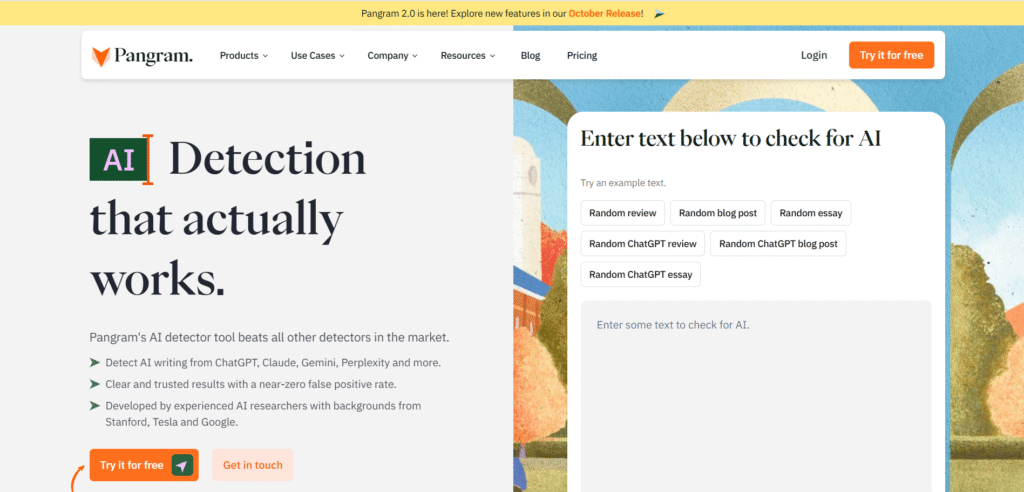
Turnitin AI Writing Detection is an advanced AI-authorship identification system integrated into the world’s most widely used plagiarism detection platform. Leveraging linguistic pattern recognition and proprietary algorithms, it distinguishes AI-generated writing from genuine human submissions with high accuracy. Turnitin’s model evaluates sentence structure, token probability, and rhythm variation — offering instructors a confidence score that indicates how much of a submission may have been AI-written. It integrates seamlessly with LMS platforms like Canvas, Moodle, and Blackboard, making it the go-to choice for academic integrity management.
Best for:
Universities, colleges, and schools ensuring authentic student submissions and AI-free assessments.
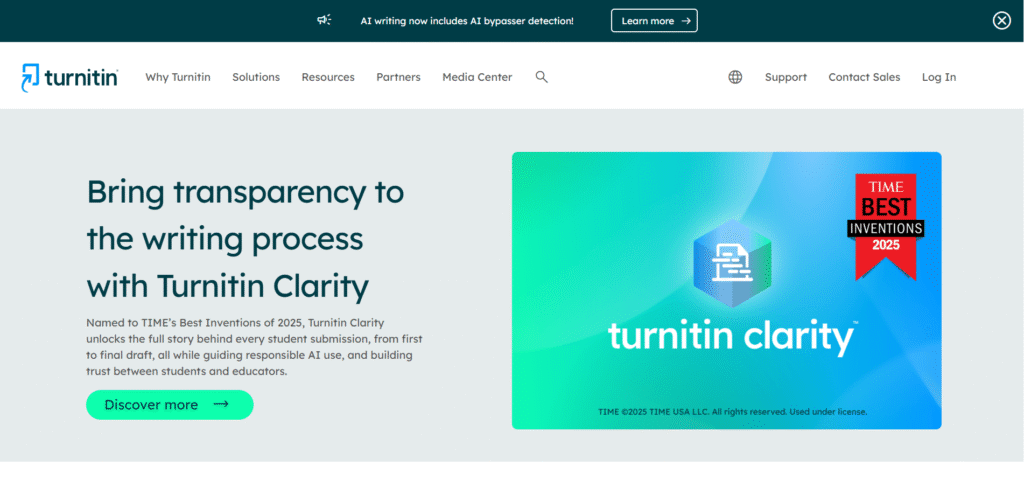
Features to Look for in AI Content Detection Tools
When selecting an AI content detection tool, consider the following features:
- Accuracy: Ensure the tool can accurately detect similarities and potential plagiarism.
- Database Size: A larger database increases the likelihood of detecting copied content.
- Ease of Use: The tool should have an intuitive interface, making it easy to check content.
- Reporting: Look for detailed and clear reports that provide actionable insights.
- Integration: Tools that integrate with other platforms (like LMS systems) offer greater convenience.
Benefits of Using AI Content Detection Tools
Using AI content detection tools offers numerous benefits:
- Ensures Originality: Helps maintain the originality of your content, crucial for academic and professional integrity.
- Saves Time: Automated checks are faster than manual reviews, saving significant time.
- Enhances Credibility: Original content boosts your credibility and trustworthiness.
- Prevents Legal Issues: Avoids potential legal problems associated with plagiarism.
How AI Content Detection Works
AI content detection tools work by using advanced algorithms to compare text against a vast database of existing content. Here’s a simplified overview of the process:
- Input Content: The user submits the text to be checked.
- Algorithm Analysis: The tool’s algorithm analyzes the text, comparing it to a database of web pages, academic papers, and other sources.
- Similarity Detection: Any similarities or matches are identified and highlighted.
- Report Generation: The tool generates a report detailing the findings, including the percentage of similarity and sources of matched content.
Challenges in AI Content Detection
Despite their effectiveness, AI content detection tools face several challenges:
- False Positives: Sometimes, tools may flag content that is not actually plagiarized, leading to false positives.
- Database Limitations: Tools are limited by the size and scope of their databases. Some content may not be detected if it’s not in the database.
- Language and Context: Understanding nuances in language and context can be difficult for AI, leading to potential inaccuracies.
Best Practices for Using AI Content Detection Tools
To maximize the effectiveness of AI content detection tools, follow these best practices:
- Regular Checks: Regularly check your content to ensure ongoing originality.
- Understand Reports: Learn how to interpret the reports generated by these tools for accurate assessment.
- Combine Tools: Use multiple tools to cross-check content for higher accuracy.
- Educate Users: Educate students, employees, and content creators on the importance of original content and how to use these tools effectively.
Future of AI in Content Detection
The future of AI in content detection is promising, with ongoing advancements in technology. Expect improvements in:
- Accuracy and Precision: Enhanced algorithms will provide more accurate and precise results.
- Real-time Detection: AI tools may offer real-time detection and reporting, making the process faster and more efficient.
- Integration: Better integration with various platforms and content management systems.
Top 10 AI Tools for AI Content Detection: Key Takeaways
- GPTZero – Detects AI-written text using perplexity and burstiness analysis, ideal for academic and editorial authenticity checks.
- Copyleaks – Multilingual AI detector with over 99% claimed accuracy, identifying content from GPT, Bard, and Claude models.
- QuillBot AI Detector – Integrated AI checker within the QuillBot ecosystem that flags machine-generated sentences in real time.
- Writer AI Detector – Scores text for AI influence and ensures originality across marketing and editorial workflows.
- Scribbr AI Detector – Academic-grade AI detection tool offering paragraph-level insights for essays and research papers.
- Grammarly AI Detector – Built into Grammarly to flag AI-generated sections while enhancing writing quality and tone.
- ZeroGPT – Provides detailed AI probability scores and multi-model text pattern analysis for educators and SEO experts.
- Originality.AI – Enterprise-level AI and plagiarism detector for publishers and agencies managing large-scale content.
- Pangram Labs AI Detector – Identifies which AI model (GPT, Claude, Gemini, etc.) likely produced the analyzed content.
- Turnitin AI Writing Detection – Integrates AI-authorship detection into plagiarism checks to ensure genuine student writing.
FAQs
What is the best AI tool for plagiarism detection? The best tool depends on your specific needs. Grammarly and Turnitin are highly recommended for their accuracy and comprehensive features.
Can AI detect AI-generated content? Yes, some AI tools are designed to detect content generated by other AI, though this is an evolving field.
How accurate are AI content detection tools? Most tools are highly accurate, but no tool is perfect. Combining multiple tools can enhance accuracy.
Are free plagiarism checkers reliable? Free tools like Duplichecker and Small SEO Tools can be reliable, but they may have limitations compared to paid options.
Can AI content detection tools be used for non-text content? Primarily, these tools focus on text, but some advanced tools are beginning to explore multimedia content detection.
Is it possible to fool AI content detection tools? While it’s possible to circumvent some detection methods, advanced tools are continually improving to minimize such risks.
Conclusion
AI content detection tools play a crucial role in maintaining content integrity in today’s digital age. By leveraging advanced algorithms, these tools ensure originality, prevent plagiarism, and uphold credibility. Whether you’re an educator, student, webmaster, or content creator, investing in reliable AI content detection tools is essential for safeguarding your work’s authenticity.
